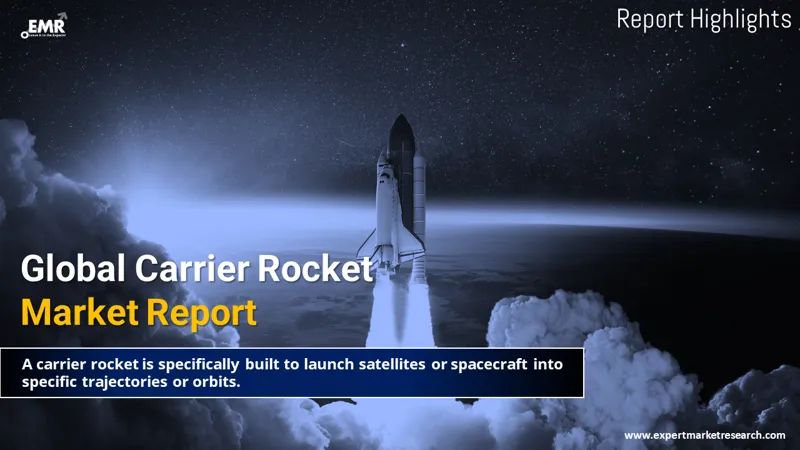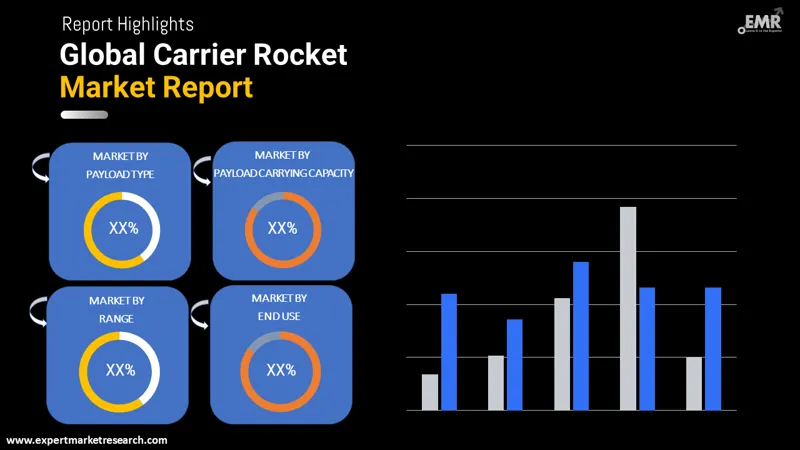
Consumer Insights
Uncover trends and behaviors shaping consumer choices today
Procurement Insights
Optimize your sourcing strategy with key market data
Industry Stats
Stay ahead with the latest trends and market analysis.
The global carrier rocket market size is expected to grow at a CAGR of 9.00% between 2026 and 2035. The market is being driven by evolution of satellite technology, rising demand for launch services, and reduced costs.
Base Year
Historical Period
Forecast Period
Compound Annual Growth Rate
9%
2026-2035
*this image is indicative*
A carrier rocket is a type of rocket that is designed to launch a payload such as a satellite or spacecraft into a specific trajectory or orbit. These rockets are typically strong and light launch vehicles that are commonly used to carry cargo for resupply missions.

Read more about this report - REQUEST FREE SAMPLE COPY IN PDF
The EMR’s report titled “Carrier Rocket Market Report and Forecast 2026-2035” offers a detailed analysis of the market based on the following segments:
Market Breakup by Payload Type
Market Breakup by Payload Carrying Capacity
Market Breakup by Range
Market Breakup by End Use
Market Breakup by Region

Read more about this report - REQUEST FREE SAMPLE COPY IN PDF
The satellite segment, by payload type, accounts for a significant share of the carrier rocket market owing to the rising demand for well-developed satellites in commercial end uses. Satellites helps telecommunications organisations implement high speed internet services all across the globe. They also aid the aviation sector in managing air traffic owing to their ability to support more efficient communication between the pilot and the air traffic controller. Satellites are also a key component in various government applications, particularly defence and security.
North America occupies a sizable share of the carrier rocket market, supported by the active space exploration sector in countries such as the United States. Development of reusable rockets are being adopted by key players in the region in an aim to reduce launching costs and delays, thereby supporting the growth of the market for carrier rockets. Meanwhile, the Asia Pacific region is expected to observe rapid growth in the market for carrier rockets over the forecast period owing to the rising space exploration activities in countries such as India, Japan, and China.
The comprehensive EMR report provides an in-depth assessment of the market based on the Porter's five forces model along with giving a SWOT analysis. The report gives a detailed analysis of the following key players in the global carrier rocket market, covering their competitive landscape and latest developments like mergers, acquisitions, investments and expansion plans.
Galactic Energy was founded in 2018 and is headquartered in Beijing, China. This space launch company works with an objective to mine asteroids for rare minerals and metals and focuses on low-cost commercial space launches.
Antrix Corporation Ltd. is defence and space manufacturing company that was founded in 1992. It is headquartered in Karnataka, India, and is known for promoting and marketing services and products emanating from Indian space programs.
IHI Corporation was established in 1853 and has its headquarters located in Tokyo, Japan. This machinery industry company manufactures and sells space launch vehicles, gas engines, ships, and aircraft engines, among others.
*Please note that this is only a partial list; the complete list of key players is available in the full report. Additionally, the list of key players can be customized to better suit your needs.*
Other market players include Arianespace, Lockheed Martin Corporation, Northrop Grumman, CubeCab, Israel Aerospace Industries, Rocket Lab USA, Inc., Space Exploration Technologies Corp. (SpaceX), Blue Origin Enterprise, L.P, and Mitsubishi Heavy Industries, Ltd., among others.




*While we strive to always give you current and accurate information, the numbers depicted on the website are indicative and may differ from the actual numbers in the main report. At Expert Market Research, we aim to bring you the latest insights and trends in the market. Using our analyses and forecasts, stakeholders can understand the market dynamics, navigate challenges, and capitalize on opportunities to make data-driven strategic decisions.*
Get in touch with us for a customized solution tailored to your unique requirements and save upto 35%!
The market is expected to grow at a CAGR of 9.00% between 2026 and 2035.
The key drivers in the market are rising space exploration activities and reduced launch cost of carrier rockets.
The key trends of the market are rising demand from end use industries, increasing investments in the evolution of satellite technologies, and technological innovations in carrier rockets.
The primary payload types of carrier rockets are cargo, and satellite, among others.
The various payload carrying capacities of carrier rockets in the market are less than 4 tons, 4 tons to 8 tons, and above 8 tons.
The major regions in the market are North America, Europe, Asia Pacific, Latin America, and the Middle East and Africa.
The significant end uses of carrier rockets are government and commercial.
The key players in the carrier rocket market, according to the report, are Galactic Energy, Antrix Corporation Ltd., IHI Corporation, Arianespace, Lockheed Martin Corporation, Northrop Grumman, CubeCab, Israel Aerospace Industries, Rocket Lab USA, Inc., Space Exploration Technologies Corp. (SpaceX), Blue Origin Enterprise, L.P, and Mitsubishi Heavy Industries, Ltd., among others.
Explore our key highlights of the report and gain a concise overview of key findings, trends, and actionable insights that will empower your strategic decisions.
| REPORT FEATURES | DETAILS |
| Base Year | 2025 |
| Historical Period | 2019-2025 |
| Forecast Period | 2026-2035 |
| Scope of the Report |
Historical and Forecast Trends, Industry Drivers and Constraints, Historical and Forecast Market Analysis by Segment:
|
| Breakup by Payload Type |
|
| Breakup by Payload Carrying Capacity |
|
| Breakup by Range |
|
| Breakup by End Use |
|
| Breakup by Region |
|
| Market Dynamics |
|
| Competitive Landscape |
|
| Companies Covered |
|
Datasheet
One User
USD 2,499
USD 2,249
tax inclusive*
Single User License
One User
USD 3,999
USD 3,599
tax inclusive*
Five User License
Five User
USD 4,999
USD 4,249
tax inclusive*
Corporate License
Unlimited Users
USD 5,999
USD 5,099
tax inclusive*
*Please note that the prices mentioned below are starting prices for each bundle type. Kindly contact our team for further details.*
Flash Bundle
Small Business Bundle
Growth Bundle
Enterprise Bundle
*Please note that the prices mentioned below are starting prices for each bundle type. Kindly contact our team for further details.*
Flash Bundle
Number of Reports: 3
20%
tax inclusive*
Small Business Bundle
Number of Reports: 5
25%
tax inclusive*
Growth Bundle
Number of Reports: 8
30%
tax inclusive*
Enterprise Bundle
Number of Reports: 10
35%
tax inclusive*
How To Order

Select License Type
Choose the right license for your needs and access rights.

Click on ‘Buy Now’
Add the report to your cart with one click and proceed to register.

Select Mode of Payment
Choose a payment option for a secure checkout. You will be redirected accordingly.
Gain insights to stay ahead and seize opportunities.

Get insights & trends for a competitive edge.

Track prices with detailed trend reports.

Analyse trade data for supply chain insights.

Leverage cost reports for smart savings

Enhance supply chain with partnerships.

Connect For More Information
Our expert team of analysts will offer full support and resolve any queries regarding the report, before and after the purchase.
Our expert team of analysts will offer full support and resolve any queries regarding the report, before and after the purchase.
We employ meticulous research methods, blending advanced analytics and expert insights to deliver accurate, actionable industry intelligence, staying ahead of competitors.
Our skilled analysts offer unparalleled competitive advantage with detailed insights on current and emerging markets, ensuring your strategic edge.
We offer an in-depth yet simplified presentation of industry insights and analysis to meet your specific requirements effectively.
Share